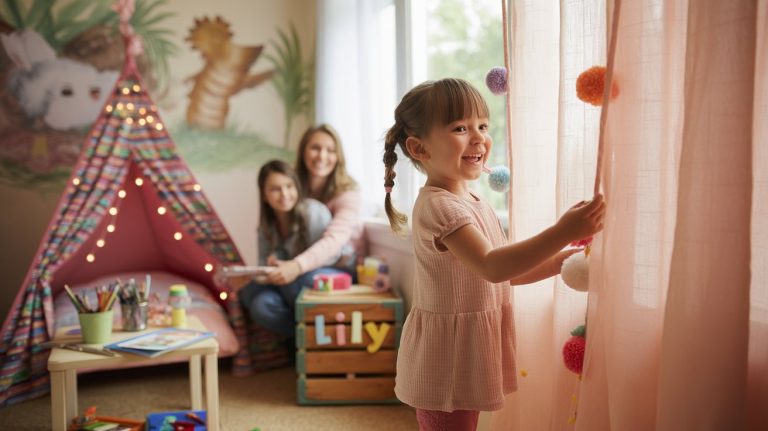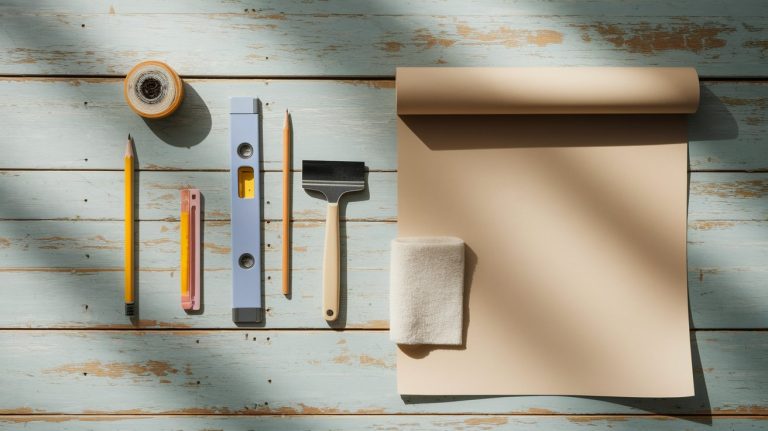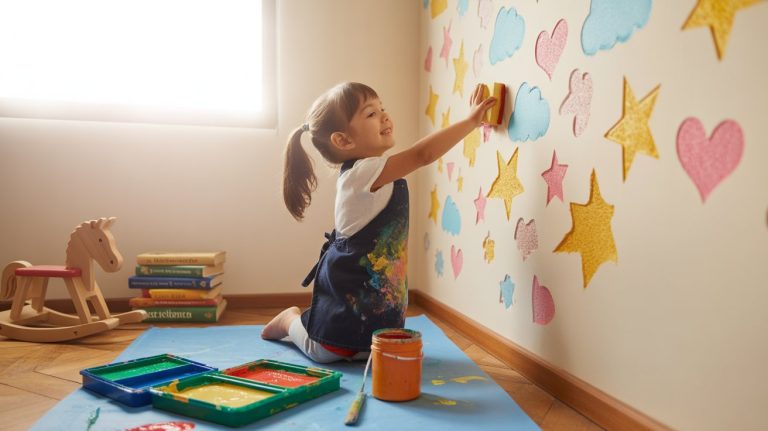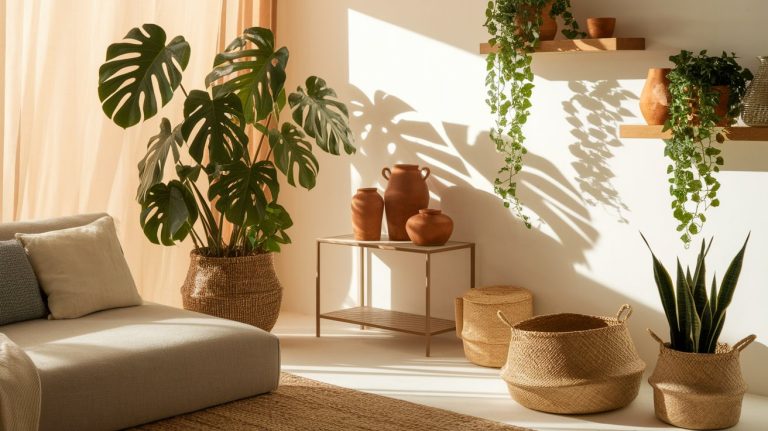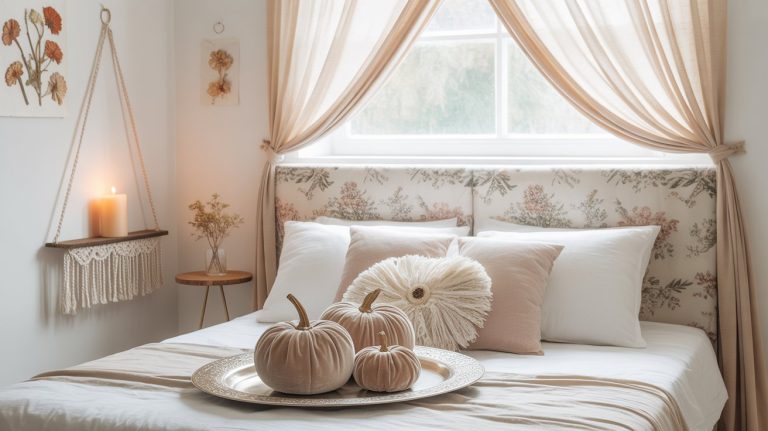10 Creative Plant Decor Inspo That Instantly Elevate Any Room
Some rooms just feel alive the moment you step into them. It’s not about the size or the furniture. It’s about energy, and more often than not, that energy comes from plants.
Houseplants have become design icons, popping up in beautifully styled corners, trailing down bookshelves, and turning windowsills into miniature greenhouses.
In this post, you’ll explore ten transformative ways to use plants that will make your home feel curated and creative.
1. Style an Elevated Shelfie with Trailing Plants
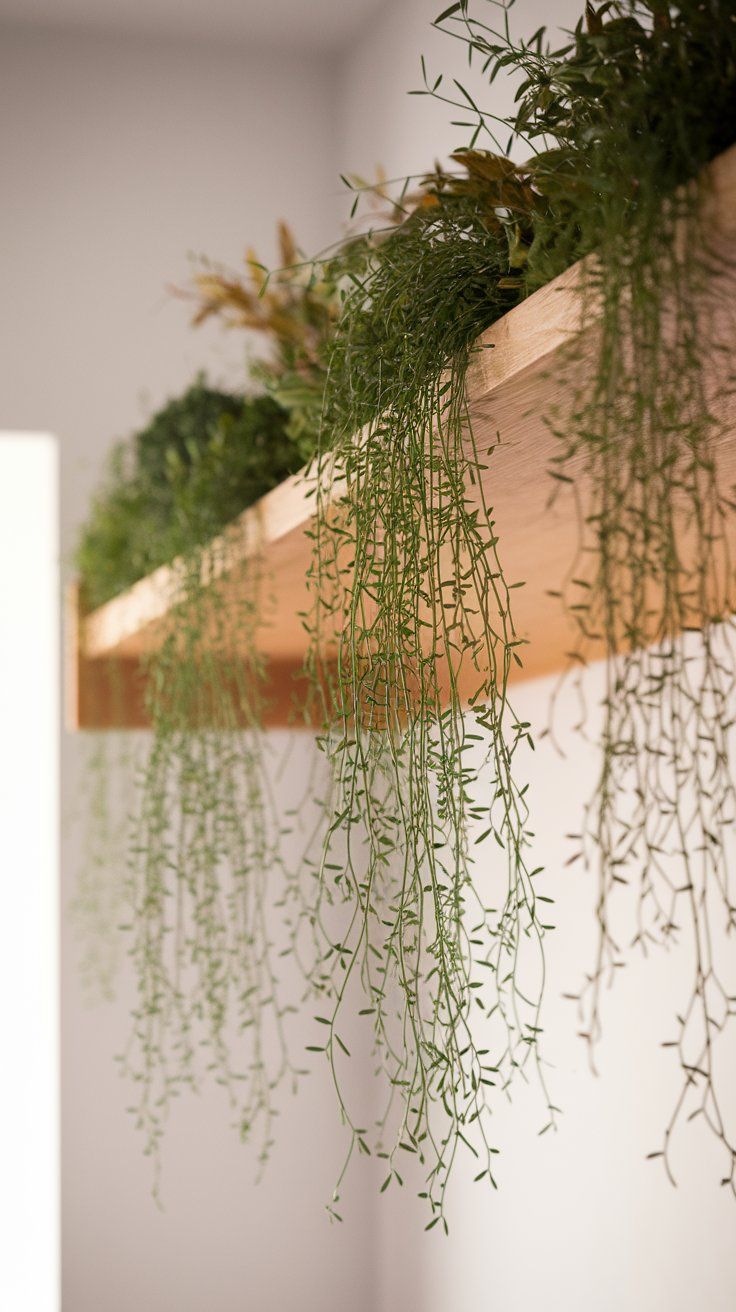
Turn open shelving into a stunning vertical garden display.
If your shelves are filled only with books and knickknacks, you’re missing an opportunity to add organic movement and freshness to your space. A well-balanced “plant shelfie” can soften rigid lines, add height variation, and introduce a more dynamic aesthetic.
Why it works:
- Trailing plants create vertical flow, breaking the flatness of traditional decor.
- The mix of natural green against manmade objects brings warmth and balance.
- Plants filter light and can soften harsh shadows from overhead lighting.
What to use:
- Trailing varieties: Pothos, String of Pearls, English Ivy, Philodendron Brasil
- Containers: Neutral ceramic pots, mini woven baskets, or glass jars for propagation cuttings
- Pairing accents: Stacked books, candle holders, framed art, ceramics
How to style it:
- Choose 2–3 shelves with good lighting (avoid dark corners).
- Place trailing plants near shelf edges so vines can hang freely.
- Anchor each shelf with a mix of heights: a tall item (like a candle), a low-profile object (like a trinket dish), and your plant spilling over.
- Repeat this formula across multiple shelves for a balanced rhythm.
Tip: For a uniform look, use planters in the same material (e.g. all white ceramic). For a more eclectic feel, play with color and texture, but tie it together with repeated shapes or plant types.
2. Transform a Bare Corner into a Layered Plant Vignette
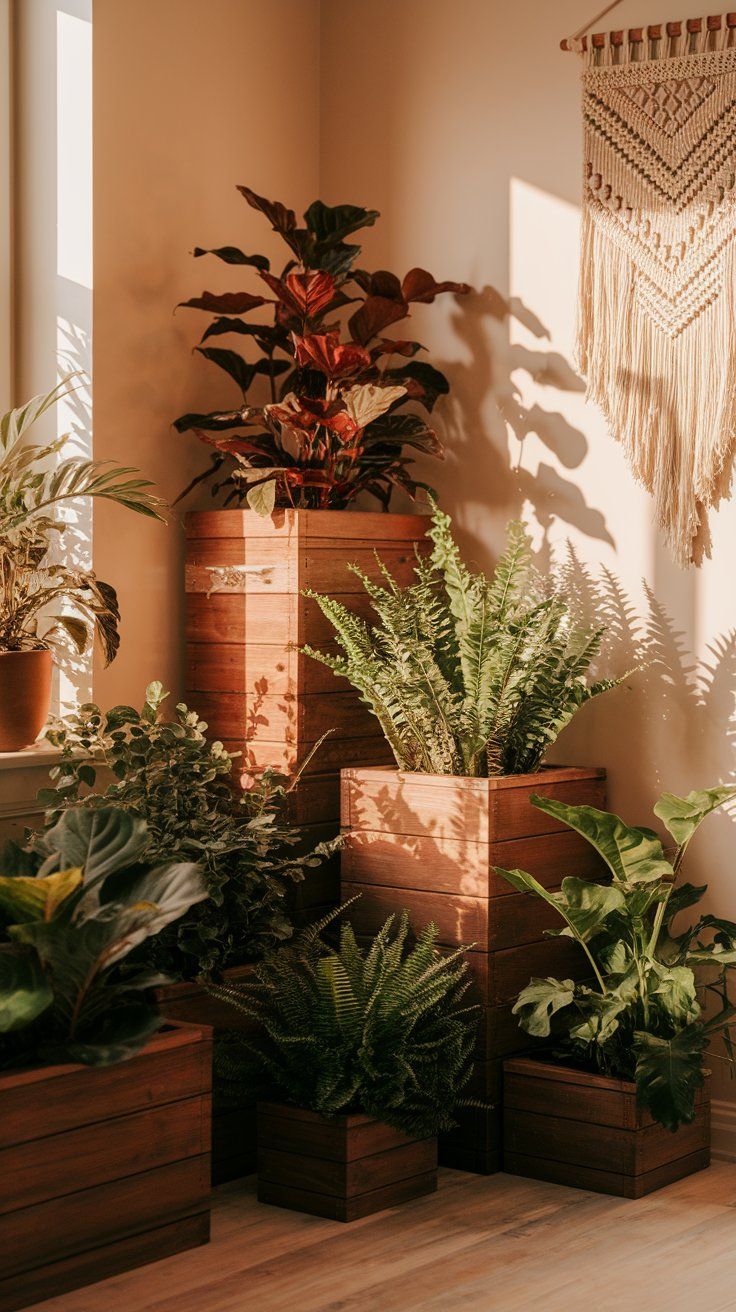
Give that awkward empty corner a purpose, and a pulse.
Every home has one: the forgotten corner that feels too big for a single plant and too small for furniture. It’s the ideal spot to build a layered, Pinterest-worthy plant nook that feels vibrant and intentional.
Why corners work beautifully:
- They naturally frame compositions, making them perfect for vertical arrangements.
- Corners can support larger plants without disrupting room flow.
- Layering plants at different heights draws the eye upward, making spaces feel taller and more designed.
Step-by-step setup:
1. Start with a tall “hero” plant: Choose something with sculptural height like:
- Fiddle Leaf Fig
- Bird of Paradise
- Parlor Palm Place it in a decorative floor pot or basket planter to anchor the space.
2. Add a medium plant on a raised surface: Stack books, use a wooden stool, or bring in a plant stand to elevate:
- Monstera
- Rubber Plant
- Dracaena
3. Finish with a low accent piece: For the front or floor level, go with:
- Snake Plant
- ZZ Plant
- Aglaonema
You can even use a short ceramic pot or woven basket to add texture at this lowest layer.
4. Style the base: To tie it all together, consider:
- A natural fiber rug (jute, seagrass)
- A sculptural side lamp
- A small table with a scented candle or ceramic bowl
Tip: Stick to one pot color palette, like all white or earth tones, to keep it cohesive, even when the leaf shapes vary.
3. Choose Statement Planters That Work Like Artwork
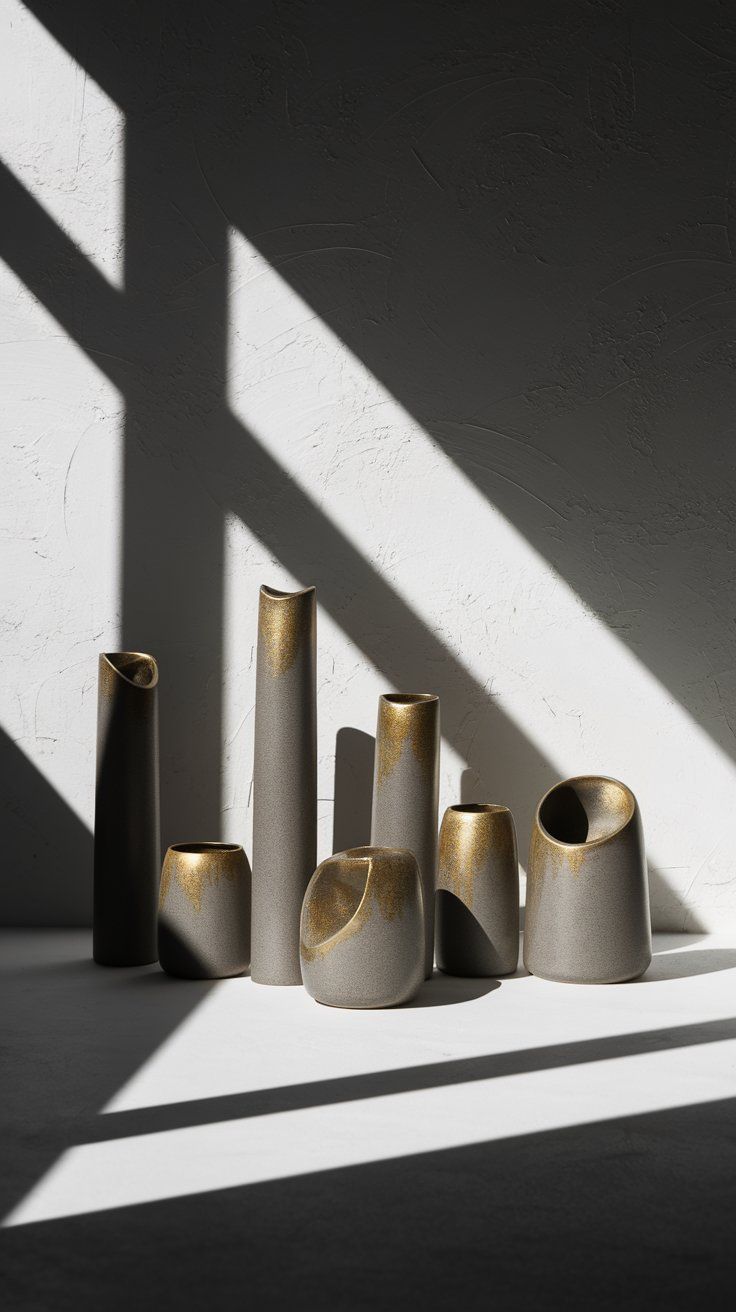
Elevate your greenery by upgrading what it lives in.
A plant is only as stylish as the pot it lives in. You can have the most lush Monstera on the block, but if it’s sitting in a faded plastic pot, the visual impact drops fast. Thoughtfully chosen planters act like mini sculptures in your room, framing your greenery while reinforcing your style.
Why it makes a difference:
- Eye-catching containers create a strong visual anchor.
- Bold pots help small or common plants feel intentional and design-driven.
- Coordinated planters across a space bring cohesion even with diverse plant types.
Planter types to try:
| Style | Materials & Textures | Vibe it creates |
|---|---|---|
| Minimalist Modern | Matte ceramic, concrete | Clean, structured, high contrast |
| Boho Natural | Woven baskets, terra cotta | Soft, warm, organic flow |
| Art Deco Glam | Brass, marble, painted gloss | Bold, rich, maximalist personality |
| Japandi Calm | Raw clay, wood tones | Earthy, calming, sculptural |
Smart placement tips:
- Use oversized pots for floor plants to give them presence.
- Place contrasting planters near neutral furniture to make the greens pop.
- Group smaller plants in matching mini pots on window sills or console tables.
Tip: If you’re working with mismatched pots, unify them with DIY techniques. You can wrap plastic pots in jute rope, spray-paint them matte black, or nest them into matching baskets for a cohesive look.
4. Elevate Your Space with Hanging Planters
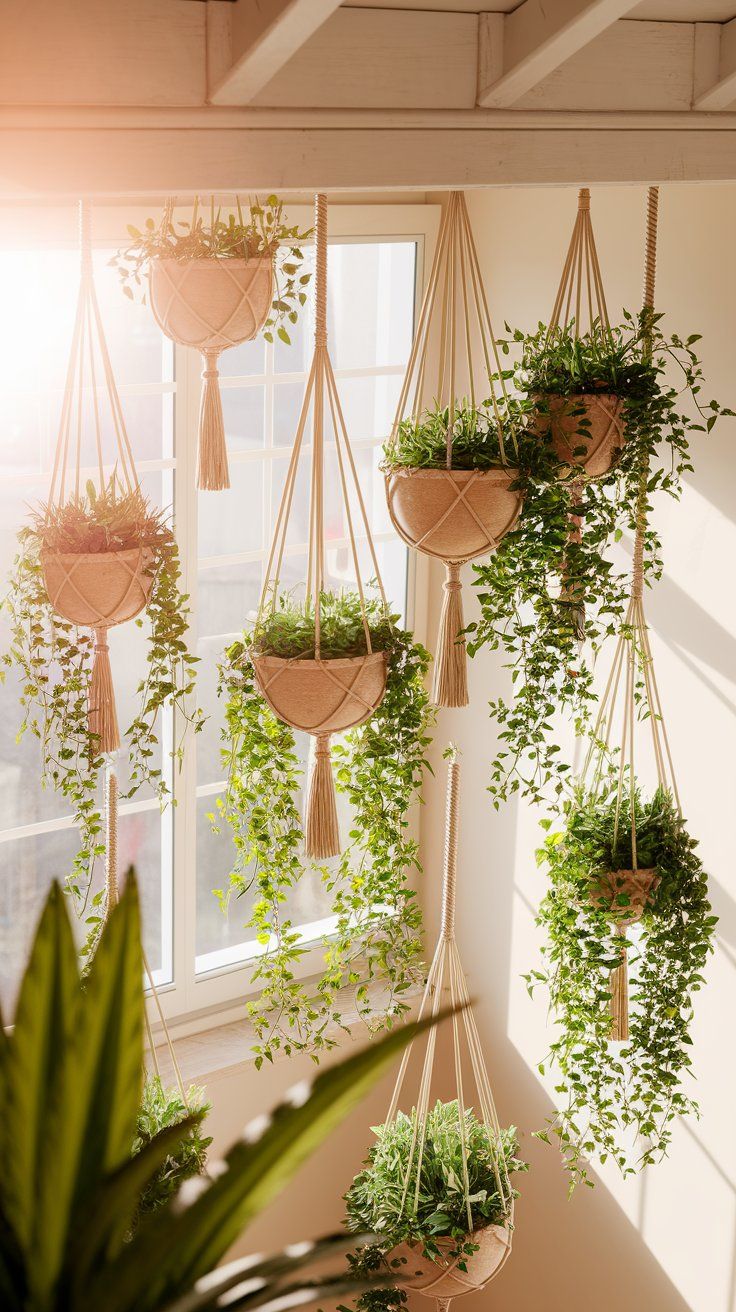
Take your plant styling to new heights, literally.
Not every room has the floor space for large potted plants, and not every surface needs to be crowded. Hanging planters offer a beautiful, space-saving way to bring in greenery without cluttering tables or shelves. They also introduce motion and softness to ceiling lines and bare walls.
Why hanging plants work:
- They draw the eye upward, making ceilings feel taller.
- They free up floor and surface space, perfect for small apartments or cozy rooms.
- Movement from hanging vines brings a touch of life and natural flow to a space.
Ideal hanging plant types:
- String of Pearls – Elegant and sculptural
- Spider Plant – Hardy and dynamic
- Boston Fern – Lush and full-bodied
- String of Hearts – Delicate with purple-tinged vines
- Philodendron Cordatum – Low-maintenance, heart-shaped leaves
Hanging options:
| Method | Best For | Bonus Tip |
|---|---|---|
| Ceiling hooks | High ceilings or corners | Use wall anchors for added stability |
| Wall-mounted brackets | Hanging just above furniture | Matches well with industrial or vintage rooms |
| Macramé hangers | Boho-inspired designs | Combine textures, wood, wool, or jute |
| Tiered plant hangers | Layering multiple small pots | Ideal for sun-filled windows |
Installation tips:
- Choose your height carefully. Hang low enough for the plant to be visible but high enough to allow vine growth or watering access.
- Mind your light source. Position hangers near windows if possible, especially for sun-loving varieties.
- Group in odd numbers. Clusters of one, three, or five tend to feel more natural and balanced than pairs.
Tip: If you’re renting, consider using tension rods between walls or adhesive ceiling hooks designed for temporary use.
5. Turn Your Bathroom Into a Mini Jungle Retreat
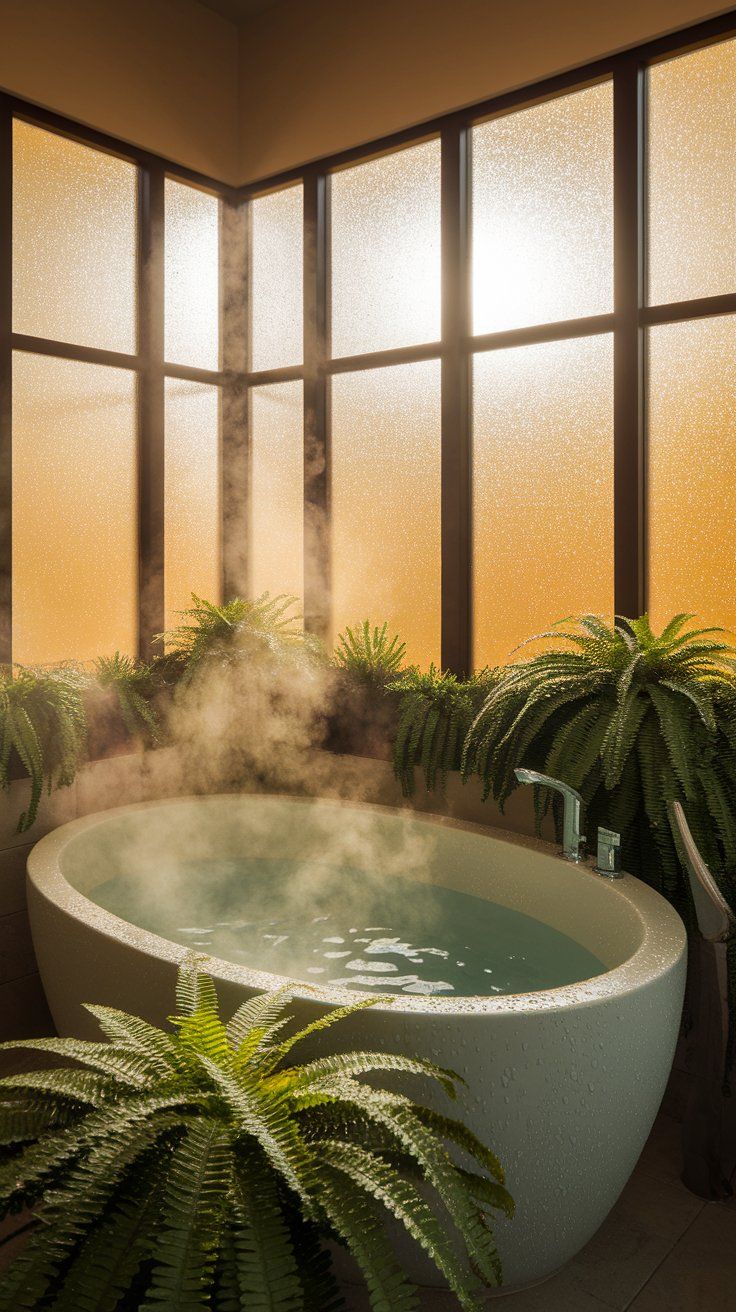
Use humidity-loving plants to soften hard surfaces and energize your morning routine.
Bathrooms are typically full of sleek surfaces, tile, glass, metal. While functional, they can feel cold and clinical. Introducing plants instantly softens the space and adds that spa-like serenity your morning (or evening) deserves. Best of all, the steam and moisture from daily showers create the perfect climate for certain species.
Why bathrooms make great homes for plants:
- They offer consistent humidity, which many tropical plants crave.
- Natural light is often diffused, ideal for low- to medium-light species.
- Plant styling in bathrooms adds a touch of organic warmth to a space dominated by hard lines and finishes.
Best plants for bathroom environments:
| Plant | Light Level | Benefits |
|---|---|---|
| Boston Fern | Indirect to low | Adds lush volume; loves humidity |
| Peace Lily | Low to medium | Purifies air and occasionally blooms |
| Asparagus Fern | Bright, indirect | Soft, feathery texture adds visual lightness |
| Spider Plant | Bright, indirect | Hardy; great for hanging baskets |
| Pothos | Low to bright | Easy to care for; trails beautifully |
Styling ideas for your bathroom:
- Floating plant shelves above the toilet or tub with small potted greens
- Macramé hangers in a corner near a frosted window
- Over-the-shower caddy with waterproof pots for trailing species
- Countertop or vanity plants in neutral-toned ceramic to blend with tile or marble
- Tub-side floor plant in a basket planter for a boutique hotel feel
Pro care tips:
- Wipe leaves weekly to remove steam residue or mineral deposits.
- Use pots with built-in drainage or add a layer of pebbles at the bottom.
- Rotate plants every few weeks to ensure balanced light exposure.
Design tip: Keep your color palette clean and calming, white planters, natural wood trays, or soft green towels pair beautifully with indoor plants.
6. Style With a Monochrome Pot Palette for Instant Cohesion
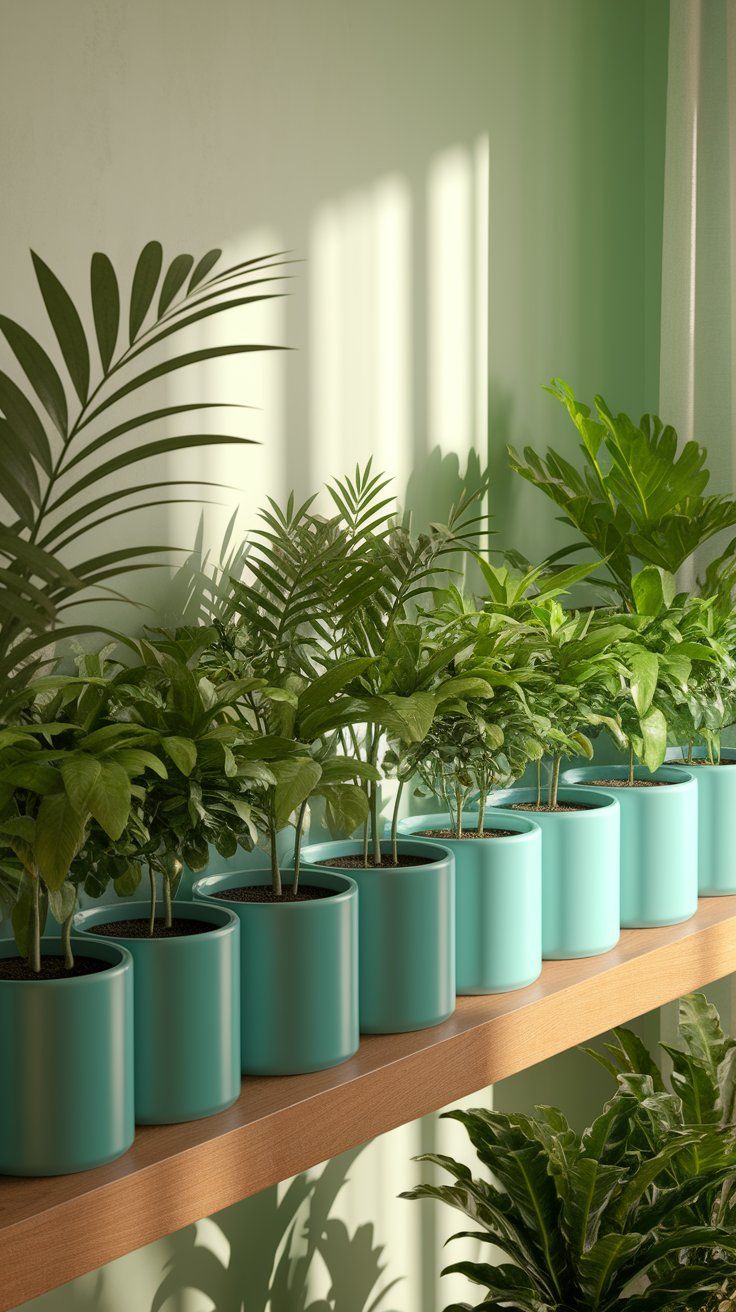
Let plant shapes do the talking by simplifying your color scheme.
A room filled with different pots, patterns, and colors can feel chaotic, even if the plants are thriving. Using a consistent pot color palette brings visual calm and allows your greenery to shine as the true star of your decor.
Why this works beautifully:
- Unifying your pot colors creates a clean, curated look without much effort.
- A neutral palette draws attention to the organic shapes, textures, and tones of the plants themselves.
- It balances out diverse plant species by visually linking them with shared containers.
Color palettes that always work:
- All-white ceramic pots for a modern, clean vibe
- Terracotta or raw clay for an earthy, rustic charm
- Matte black or slate grey for bold contrast in bright or minimalist rooms
- Woven baskets with plastic liners if you prefer a natural, boho look
How to implement the monochrome effect:
- Take stock of your existing planters. Group any similar shades or textures together.
- If you have mismatched colors, wrap pots in jute, repaint them with matte spray paint, or nest them inside uniform baskets or sleeves.
- Stick to one or two pot styles per room to maintain consistency.
Design enhancement: Cluster multiple plants in monochrome pots together on sideboards, floating shelves, or window ledges. Keep the plant foliage varied to avoid visual repetition, combining trailing vines, tall upright leaves, and bushy greens makes the whole composition more vibrant.
Tip: Use planters with subtle surface patterns (like ridges or fluting) to add texture without introducing new colors.
7. Style Bookshelves With Greenery That Breathes Life Into Your Decor
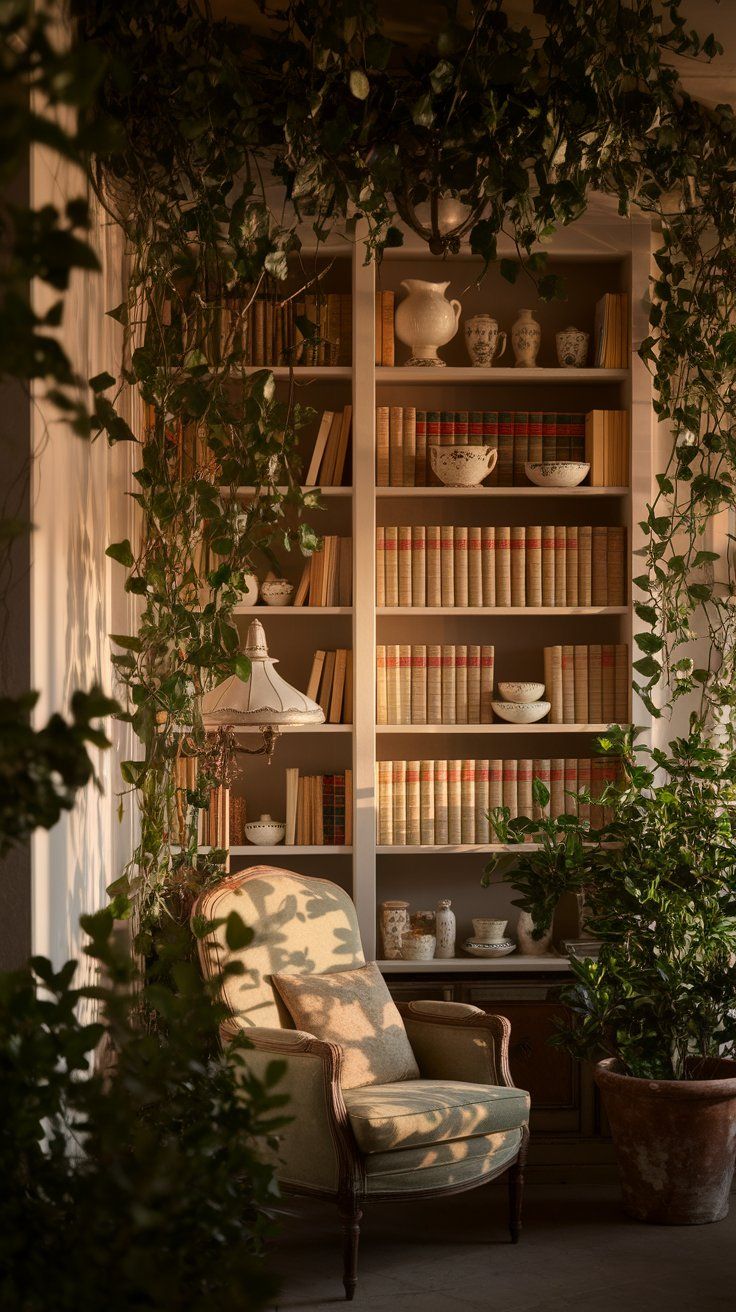
Blend books and botanicals for a shelf that feels curated, not cluttered.
Bookshelves are often filled with rigid lines and blocky forms. Adding plants is a simple way to soften the structure and add a sense of movement. The key is to balance function (storage) with flow (greenery) for a shelf that feels organic and thoughtfully styled.
Why greenery belongs on your shelves:
- It breaks the monotony of stacked books and square decor.
- Trailing plants can add depth, drape, and softness across visual planes.
- Green accents help connect design elements across the room.
Best plant choices for shelves:
- Trailing: Golden Pothos, English Ivy, String of Pearls
- Compact upright: Snake Plant (small variety), Mini Rubber Plant, Peperomia
- Low profile: Air Plants, Aloe Vera, Succulents (Haworthia or Echeveria)
How to style your shelf like a designer:
- Vary height and direction. Place some upright plants on stacked books for lift, and let trailing plants drape over the edges.
- Use plant clusters as “visual pauses.” Nest a small trio of plants between objects to reset the eye.
- Balance both sides. Don’t overload one end. If a larger plant sits on the left, counter it with a taller stack of books or frame on the right.
- Leave breathing room. Let each shelf have at least one negative space to avoid visual overwhelm.
Styling combo that works every time:
- Left: Stack of 3 neutral books
- Center: Mid-sized plant in a textured pot
- Right: Leaning print or candle holder
- Accent: One trailing vine draping downward
Tip: Stick to a cohesive color scheme across your planters and book jackets, this will help even a full bookshelf feel polished.
8. Create a Mini Desk Garden That Inspires Focus and Calm
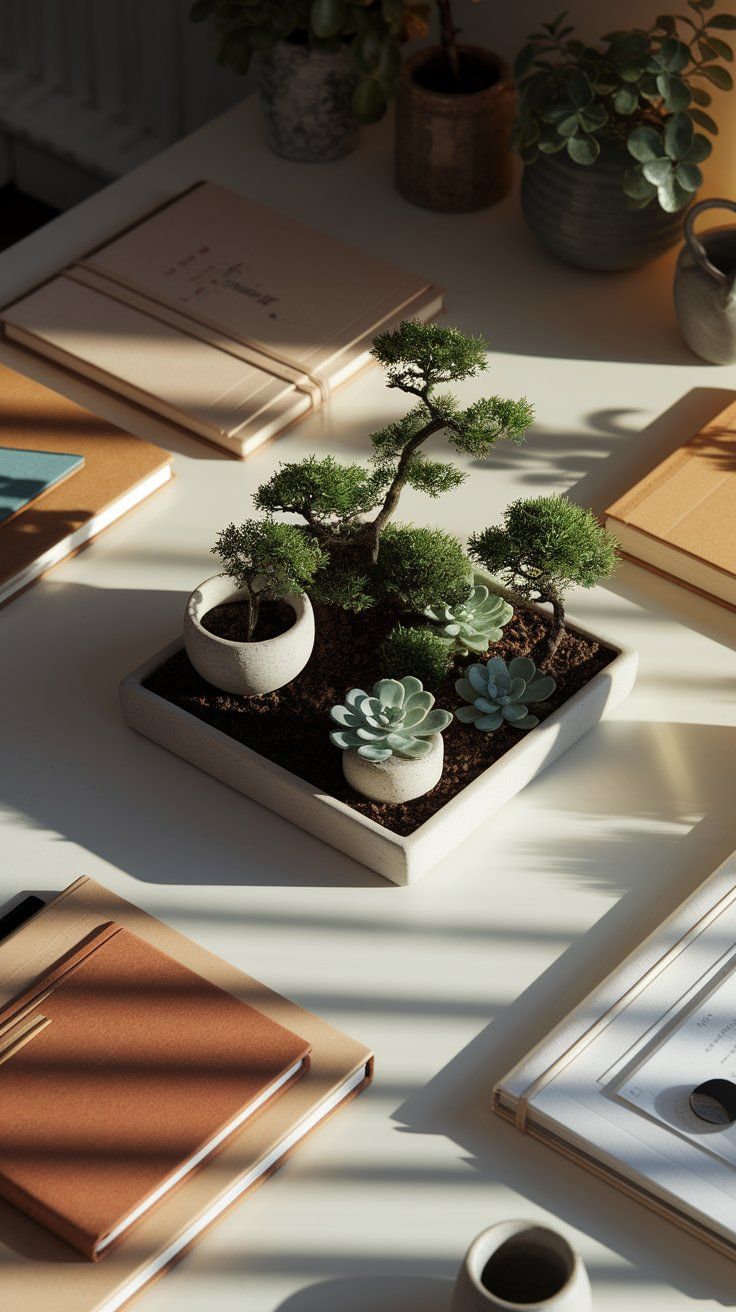
Let nature be your desk mate.
Your workspace isn’t just for productivity. With just a touch of greenery, it can become a zone of calm, creativity, and light energy, even during busy days. Adding small, easy-to-care-for plants to your desk helps reduce stress, purify the air, and bring a more grounded presence into your workflow.
Why a desk garden makes a difference:
- It provides visual rest from screen time and structured materials.
- The ritual of tending to a plant, even briefly, can reset mental focus.
- A few well-placed leaves add warmth and dimension to the clean, angular lines of laptops and monitors.
Ideal plant choices for desks:
- Air Plants: No soil required; rest them in a shallow dish, shell, or crystal cluster.
- ZZ Plant (small variety): Tolerates low light and very little watering.
- Mini Succulents: Need bright light and infrequent care; perfect for windowsill desks.
- Pilea Peperomioides (Chinese Money Plant): Cute shape and easy to grow in small pots.
- Baby Rubber Plant: Glossy and compact, great for minimalist setups.
Smart placement ideas:
- Place one plant just beside or behind your laptop to soften the screen line.
- Cluster two or three on the corner of a desk tray or floating shelf above your work area.
- Add one next to your desk lamp to balance light with nature.
Styling tips for a clean, inspiring look:
- Use neutral-toned planters like white matte, soft beige, or mini cement pots.
- Elevate tiny pots on coasters, wooden risers, or book stacks for height variation.
- Pair your plant with one small personal item, a photo, crystal, or diffuser, to build an intentional vignette.
Tip: Stick with low-maintenance plants so your desk garden stays lush even on your busiest weeks. A neglected plant on a desk can feel like visual guilt, choose one that thrives with minimal attention.
9. Create a Window Ledge Greenhouse That Grows With Style
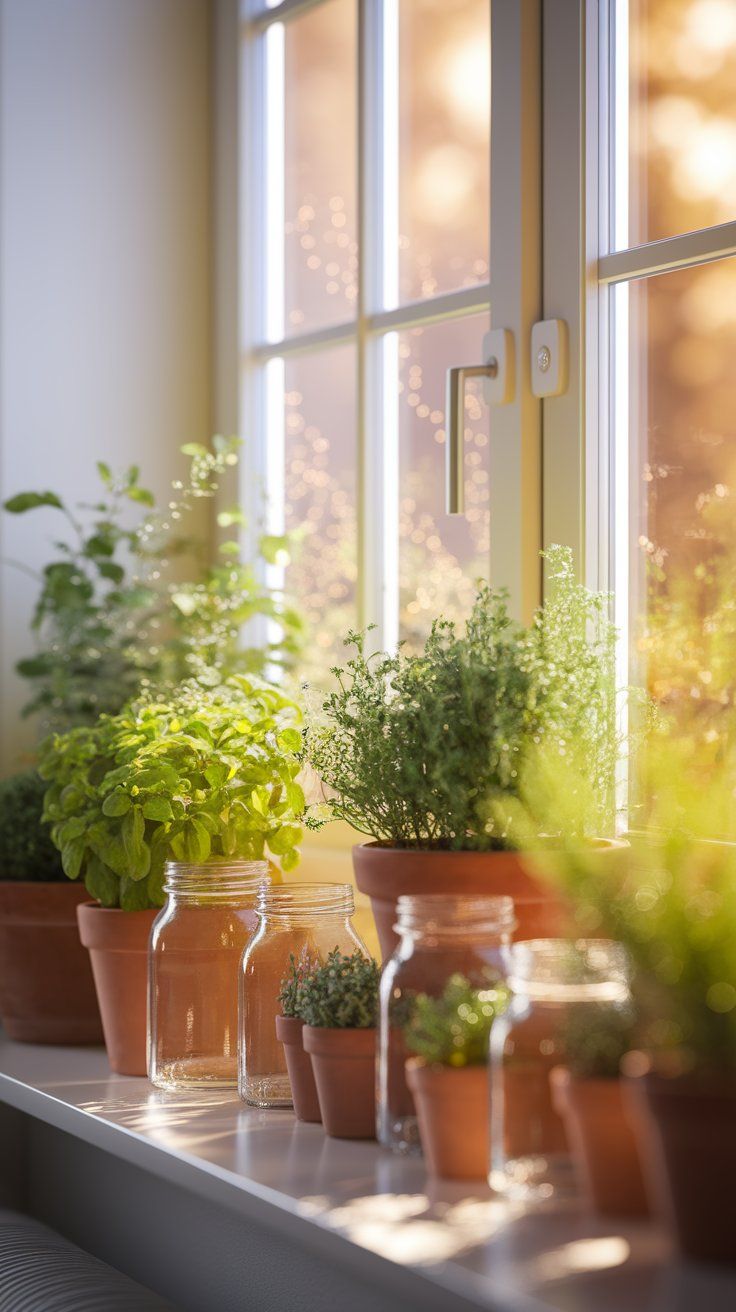
Bring nature indoors with a sun-drenched mini garden.
Windows are natural gathering points for light, and the perfect home for thriving greenery. A well-styled ledge turns forgotten sill space into a functional garden, a visual mood booster, and in some cases, a mini harvest station.
Why window ledge styling works:
- Bright windows provide natural light that many indoor plants crave.
- Greenery softens the architectural lines of windows and adds visual weight to empty sills.
- Herbs and cuttings grow fast here, making it both beautiful and useful.
Plant suggestions for window sills:
- Bright, sunny windows: Aloe Vera, Basil, Rosemary, Echeveria (succulent)
- Low to medium light: Pothos, Snake Plant (small variety), Peace Lily
- Propagation stars: Monstera cuttings, Pothos stems, Tradescantia in jars of water
Creative styling ideas:
- Use matching glass bottles or jars for propagating cuttings. Group them in threes with varying heights.
- Arrange tiny pots in a line for an aesthetic herb garden, bonus if you label them with mini chalkboard signs.
- Add pebbles or marble chips to the base of clear pots for texture and drainage.
- Elevate a few plants using small wooden blocks to vary the height and add dimension.
Design tip: Choose one material theme, like all clear glass or all terracotta, for the containers to avoid a cluttered look. Complement the green tones with neutral linens, soft wood finishes, or sheer white curtains.
> For a full greenhouse effect, you can also install a floating shelf just above the sill to add a second layer of plant life and create an eye-level feature.
10. Style Tall Furniture With Trailing Plants for Effortless Vertical Impact
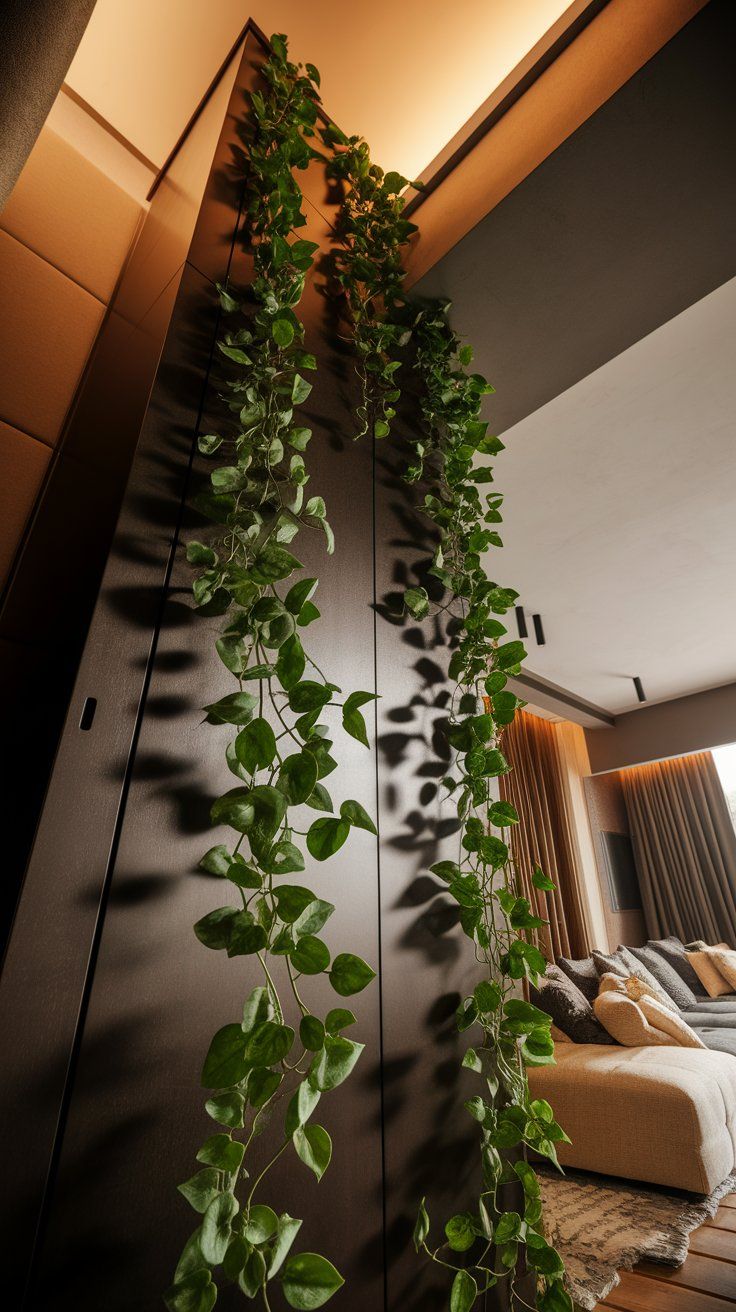
Let vines spill from above to soften edges and elevate your space.
That forgotten top shelf or wardrobe isn’t just collecting dust, it’s prime real estate for greenery. Adding trailing plants to the upper edge of tall furniture introduces a striking vertical element, fills dead zones near the ceiling, and brings your entire room to life from the top down.
Why this technique works beautifully:
- Plants flowing from above guide the eye upward, making ceilings feel taller.
- It adds natural softness to harsh architectural lines.
- Greenery at elevation balances rooms that are visually bottom-heavy (think low sofas, floor rugs, or short tables).
Best trailing plants for tall furniture styling:
- Golden Pothos: Fast-growing and cascades effortlessly
- Heartleaf Philodendron: Elegant heart-shaped leaves with low maintenance
- Spider Plant: Hardy with dynamic baby shoots
- English Ivy: Delicate, traditional, and lovely for layering
- String of Hearts: Compact, patterned vines for smaller shelf edges
Where to style this look:
- On top of wardrobes: Drape vines down corners or over the front edge
- High kitchen cabinets: Add visual interest and warmth to sterile upper cabinetry
- Tall bookshelves: Balance vertical space and create depth
- Above the fridge or pantry: Use in neutral kitchens to add softness and color
Safety + styling combo tips:
- Use lightweight pots with saucers to protect furniture from moisture.
- Angle the front edge of the planter slightly forward using a coaster or wedge to encourage trailing.
- Avoid overwatering. Use plants with low water requirements to minimize risk of leaks.
- Tuck in a small up-light or LED strip to highlight the cascading leaves in the evening.
Creative detail: Mix textures by pairing soft vines with ceramic vases or wood carving accents. This creates a contrast that feels earthy, refined, and layered.
Conclusion: Grow a Space That Feels Like You
Great plant decor isn’t just about following trends or getting the perfect “look.” It’s about building an environment that breathes with you, day by day. The way a vine leans toward light, the way a fern spills over its pot, the way a shelf comes to life with just a touch of green, these details shape how a room feels.
Start small if you need to. Style one corner. Re-pot one plant. Rearrange one shelf. Each choice pulls you closer to a space that feels calming, creative, and fully your own.
Plants remind us that beautiful things don’t happen all at once. They grow. So does your home.
Related Articles:


